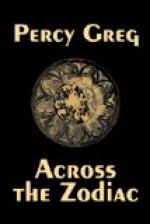This source of disturbance extinguished in the reign of the twenty-fifth predecessor of my royal patron, the construction of the great Observatory on Eanelca was commenced. A very elaborate road, winding round and round the mountain at such an incline as to be easily ascended by the electric carriages, was built. But this was intended only as a subsidiary means of ascent. Eight into the bowels of the mountain a vast tunnel fifty feet in height was driven. At its inner extremity was excavated a chamber whose dimensions are imperfectly recorded in my notes, but which was certainly much larger than the central cavern from which radiate the principal galleries of the Mammoth Cave. Around this were pierced a dozen shafts, emerging at different heights, but all near the summit, and all so far outside the central plateau as to leave the solid foundation on which the Observatory was to rest, down to the very centre of the planet, wholly undisturbed. Through each of these, ascending and descending alternately, pass two cars, or rather movable chambers, worked by electricity, conveying passengers, instruments, or supplies to and from the most convenient points in the vast structure of the Observatory itself. The highest part of Ranelca was a rocky mass of some 1600 feet in circumference and about 200 in height. This was carved into a perfect octagon, in the sides of which were arranged a number of minor chambers—among them those wherein transit and other secondary observations were to be taken, and in which minor magnifying instruments were placed to scan their several portions of the heavens. Within these was excavated a circular central chamber, the dome of which was constructed of a crystal so clear that I verily believe the most exacting of Terrestrial astronomers would have been satisfied to make his observations through it. But an opening was made in this dome, as for the mounting of one of our equatorial telescopes, and machinery was provided which caused the roof to revolve with a touch, bringing the opening to bear on any desired part of the celestial vault. In the centre of the solid floor, levelled to the utmost perfection, was left a circular pillar supporting the polar axis of an instrument widely differing from our telescopes, especially in the fact that it had no opaque tube connecting the essential lenses which we call the eye-piece and the object-glass, names not applicable to their Martial substitutes. On my visit to the Observatory, however, I had not leisure to examine minutely the means by which the images of stars and planets were produced. I reserved this examination for a second opportunity, which, as it happened, never occurred.




